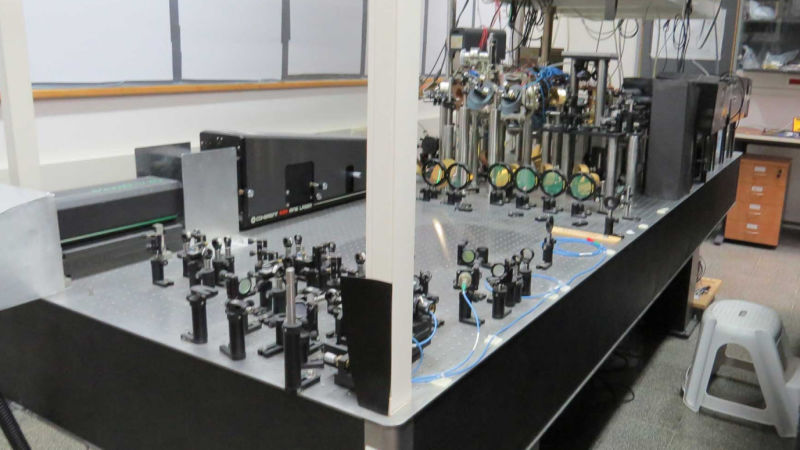Physicists have confirmed predictions of Stephen Hawking’s namesake theory of black holes using a black hole they constructed in their lab, according to a new paper.
This black hole isn’t like the black holes out in space, where gravity creates a region of spacetime so warped that light can’t escape. Instead, the researchers built a black hole analog using a strange quantum material called a Bose-Einstein condensate, in which the point of no return is for sound rather than light. Still, it’s an important verification Hawking’s work.
“I’m interested in learning whatever we can about real black holes and real gravity,” study author Jeff Steinhauer, physicist at the Technion-Israel Institute of Technology, told Gizmodo.
Stephen Hawking’s landmark theory is called Hawking radiation. When trying to apply the physical laws governing heat to black holes, he realized that black holes must emit radiation from their surfaces. The mechanism marks a combination of quantum mechanics (the science of the smallest things) with gravity (the science of interactions between the most massive things). But astronomers haven’t been able to peer close enough to a black hole to prove or disprove the theory. Some scientists have instead turned to analogues in the lab.
The scientists created an elongated Bose-Einstein condensate by trapping 8,000 rubidium atoms in a focused laser beam. Bose-Einstein condensates are systems of ultra-cold atoms where strange quantum physical phenomena become more visible on larger scales. They are often used for analog-type experiments like these.
A second laser increases the potential energy on one side of the Bose-Einstein condensate, making it denser on that side. A sharp transition separates the denser area (considered to be outside the black hole) and the less dense area (inside the black hole). This transition moves at a constant speed through the condensate, but from the point of view of the experimenters, it appears to be stationary; instead, it looks as if all of the rubidium atoms are moving. Outside the black hole in the denser region, the speed of sound is faster than the speed of this flow, so sound waves can move in either direction. But in the less dense region—inside the black hole—the speed of sound is slower, so sound waves only travel away from the sharp transition and further into the black hole, as described in the paper published in Nature.
This experiment mimics one of the most important features of the black hole—outside the black hole, light can either move away from or into the black hole. But once inside the black hole, it cannot escape. The laboratory analogue replaces light with sound, and the researchers can measure sound waves both outside and inside inside their black hole’s “event horizon.” The signal of the Hawking radiation is a correlation between these two kinds of waves.
Steinhauer’s team previously observed Hawking radiation in this system back in 2016. But this time around, they made at least 21 improvements to the system in order to get a better signal. This was enough to pull out important information about the system’s radiation, namely that it has a thermal spectrum with a temperature determined only by the system’s analogous equivalent to gravity, a relationship between the speed of sound and its flow. This means that it emitted a continuous spectrum of wavelengths, rather than preferred wavelengths. These observations, and the temperatures, were exactly as predicted in Hawking’s theories.
“The way I see it, what we saw was that Hawking’s calculations were correct,” Steinhauer said. By correct, he means that they’re a real effect that happens in these kinds of systems. Whether they happen in real black holes in space, well, we don’t quite know yet. But they do show that if Hawking was correct, then any information that falls into a black hole is lost, the subject of an important black hole paradox.
Mathematician Silke Weinfurtner at the University of Nottingham in the United Kingdom wrote in a Nature commentary that the research was “promising” and that the scheme the researchers used to extract the temperature of the radiation was “clever.” Perhaps, she wrote, the setup will be useful in measuring other interesting quantum phenomenon expected to occur near the black hole’s event horizon.
This research is yet another example of scientists using analogues to access physical phenomena that might otherwise be impossible to observe. It can serve as an important verification of the theories that drive our understanding of inaccessible things.
Next up, the researchers hope to repeatedly redo the experiment in order to determine how this Hawking radiation changes over time. And who knows, maybe one day we really will be able to measure these properties in actual black holes.
Source: Laboratory Black Hole Shows Stephen Hawking Was Right, Obviously

Robin Edgar
Organisational Structures | Technology and Science | Military, IT and Lifestyle consultancy | Social, Broadcast & Cross Media | Flying aircraft

